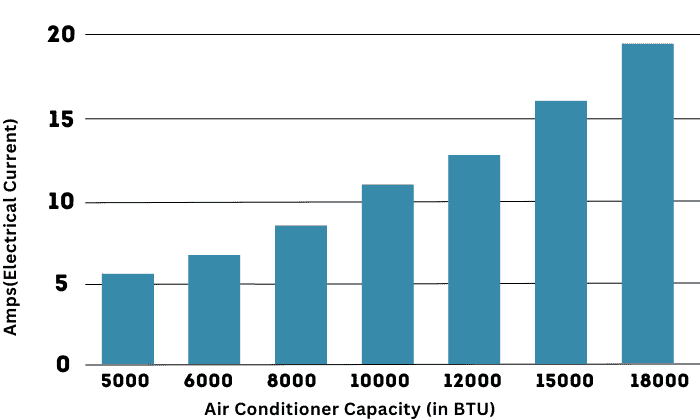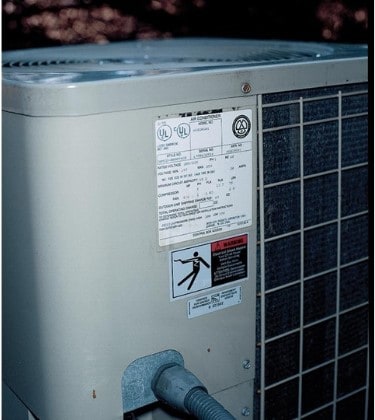When it comes to an AC unit, its amp usage is essential knowledge. Knowing the current the air conditioner uses, you can properly design your circuit so that your appliance has enough power to keep working efficiently.
In this article, we will explore how many amps does a 5 ton AC use. So, let’s get into the specific details below.
Table of Contents
5 Ton AC Amperage
As we seek efficient and effective ways to cool our homes, understanding the energy consumption of an AC unit is essential. It includes finding the circuit amperage that provides optimal performance and a steady power supply.
Usually, you can always find an AC amp chart online, which includes the information you need. However, it is essential that you have some idea of how the calculation works. Therefore, here’s a simple guide to help you get the necessary information.
Calculating Amps for a 5-ton AC
Calculating the amp draw of an AC requires a few easy steps and knowledge regarding power ratings, efficiency or SEER, and voltage. This information is frequently seen on the unit’s label.
When it comes to an air conditioning unit, always remember that one ton is equivalent to 12,000 BTU. Moreover, the SEER ratings range from 13 to 25, and the voltage is dependent on the model you have.
Now, to get the amperage rating of an AC in both single and 3 phase amps, you can use the formula:
\[ \frac{BTU}{(SEER \times 0.875) \times \text{Volts}} \]
For example, if you have a single phase 5-ton AC (60,000 BTU) unit with a 240V power supply and a SEER rating of 14, the calculation will be:
\[ \frac{60,000}{(14 \times 0.875) \times 240\, \text{V}} = 20.41\, \text{Amps} \]
This shows that the 5 ton AC unit amps is 20.41.
For convenience, an AC amps calculator also gives you the same result. This tool swiftly provides the desired measurement by inputting essential data like BTU, SEER, and voltage rating, streamlining your calculation process.
Factors Affecting AC Power Usage
Understanding the numerous elements that influence AC power use is critical, particularly when looking for strategies to save energy. Here are some of the most common factors that influence the power consumption of your air conditioner.
- The setting of an AC fan can significantly impact energy consumption. Normally, an AC unit that has a fan with auto mode is much more efficient, as it automatically adjusts its speed based on cooling needs.
- Poor air quality can clog filters and make your AC work harder, so clean the filters regularly.
- The weather outside plays a pivotal role in determining how much energy your AC uses. On hotter days, your AC has to work harder to combat rising temperatures.
- Older ACs tend to be less energy-efficient compared to newer models. Units older than ten years will increase your electrical bills, so replacing them is wise.
- The type of AC system you have matters. Ducted designs generally have the best efficiency, and modern inverter technology in some AC units adjusts the compressor speed, consuming less energy while maintaining a consistent temperature.
- The cooling capacity of your AC, often measured in tons, impacts its power usage. An oversized AC can cycle on and off more frequently, wasting energy. Conversely, an undersized unit might struggle to cool your space, leading to extended operation times.
- The size of the room being cooled directly influences electrical usage. A smaller room requires less cooling effort compared to a larger space.
- Appliances such as ovens, stoves, and even electronics generate heat that contributes to indoor temperatures. When your AC senses rising temperatures, it ramps up its cooling efforts, thereby consuming more power.
Conclusion
Knowing how many amps does a 5 ton AC use only requires some information about the unit and basic calculation. Understanding AC amp draws makes you a more informed and efficient consumer, allowing you to make decisions that benefit your comfort and energy savings.
When selecting a breaker for your AC, you must consider the starting amps in addition to the amps draw. The current draw during start-up is higher than running amps. As a result, you should consider using a much larger circuit breaker and wire that can withstand this amp rating.

I am Edwin Jones, in charge of designing content for Galvinpower. I aspire to use my experiences in marketing to create reliable and necessary information to help our readers. It has been fun to work with Andrew and apply his incredible knowledge to our content.



